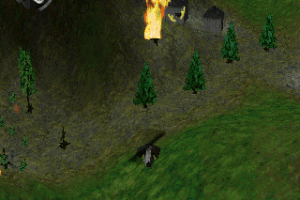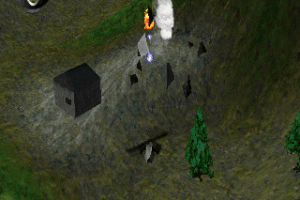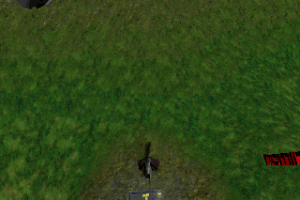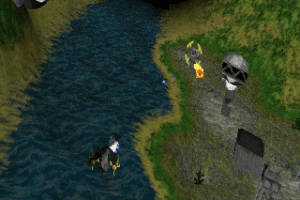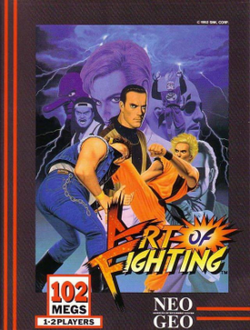
Since the first Sim City, I have always enjoyed Maxis games for their
ability to develop highly addictive games. "Sleepless nights in Sim
City" could be the book's title where I would describe the countless
hours I spent on this game and especially on its sequel, Sim City 2000.
Therefore, you will easily understand that I was very happy when the
final version of Sim Isle arrived on my desk.
The very first thing
you will recognize is the 3D isometric view like in Sim City 2000, but
if you compare the two of them longer, you will notice many differences.
There are no icons representing the various types of buildings and
other facilities, but instead you will find photos of the agents that
you can select for different tasks. The view can be changed in many
ways. There are three levels of zoom from a general panorama of the
island to a more appropriate "working" map to closely watch what is
going on. You can also rotate the map 90ø degrees to the left or to the
right depending on which arrow you selected, and also lower or raise
your point of view. This way, you will gradually pass from a flat
perspective with a vertical view to a ground-level viewpoint with the
kind of perspective that we, humans, are used to when we look around us.
However, the default view is the same as in Sim City 2000 which is far
the best, and I strongly recommend everyone to keep it like this. If you
are curious to see what the island orientation arrows do to your view,
check it out, but you will quickly realize that it is not very useful.
The
satellite view offers a two-dimensional map of the terrain that allows
you to visualize many things such as iron and coal deposits, polluted
zones, routes, industrial areas, logging spaces, etc... The colored
legend indicates the zones on the map with the brightest colors for rich
deposits or important amounts of pollution or traffic for example, and
the contrary for poor deposits. The other arrows on the interface map
are used to pan the view in the direction you want to move, but you can
also use the mouse directly on the view by clicking on the right button
to advance where you want to go.
Well, enough talk about the view
and its interface, and let's take a look at the agents. Each agent has
one, two or even three special skills such as negotiation, employment,
industrial, local ecology, exploration, etc... There are 24 agents to
choose from and their choice must be based on your needs as it will cost
you money to hire them. Each time you play a game, a group of agents
will already be at your disposal, but if you prefer new agents, you can
fire those you don't like and replace them. Whenever you want to use an
agent, simply click on the photo to have a copy of his record, or to
send him to a place where his skills are needed. For example, if you
want to build a new structure, you will need an agent with construction
skills at the construction site. Another example is with the industries
where you need to hire extra workers to increase the production, and
therefore you will have to send an agent with employment skills to the
plant.
There are two different ways to play with Sim Isle. The
first one is to complete a series of scenarios (25 to be exact), each
with different goals and increasing in difficulty and the second is
called "freeplay" mode where you manage the island and its resources
without any other goals than making the island rich and prosperous.
Sim
Isle is, however, not a rehash of Sim City 2000. In Sim City, you had
to start and develop the town which means you had to deal with problems
such as transportation, pollution, crime, power generation, housing,
business, fire protection, etc... In Sim Isle, you must not take care of
roads for example as they are automatically built when you install new
sites. In fact, you can no longer manage the town as it was possible
with Sim City 2000. The only things you can do with towns in Sim Isle is
to build hospitals, educational and recreational structures and
spiritual centers. You must check that the city is supplied with power
and that is about all on towns. The environment is the most important
thing in Sim Isle. You must extract raw materials from mines or the
forest, supply heavy industries and other factories to produce
manufactured goods. These products will increase the comfort of the
inhabitants and will provide the necessary financial resources to
continue your expansion. However, you must take care of the environment
by checking that pollution is not threatening life, that the rainforest
is not being depleted, that wild life is not heading for extinction,
etc...
The SVGA graphics allow many details on the map such as
trucks moving on the roads, small airplanes and even boats. Other
details include the vegetation which features various colors that change
because of the sun's movement across the horizon, the very realistic
relief on the island, etc...
I forgot to mention the notebook, an
online manual with information regarding the agents, ecology,
population, industries and enterprise zones. It is a nice feature that
quickly gives you all you need to know about a specific subject. The
graph option will display charts with a wide range of statistics about
your production and the resources.



